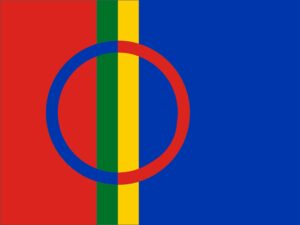Symbols of The Sami People
The Sami are often referred to as one people, but they are in fact several peoples. The various sub-groups have common ethnic and linguistic roots, but still individual identities and languages.
Historically, the Sami lived in areas stretching across today’s Norway, Sweden, Finland, and Russia. Sapmi is the common name used for these territories today.
The historical Sami were fishers, hunters, and gatherers. Against all odds, the Sami ways of life survived well into our own time – and continue today, adapted to the modern-day world.
From the early 1900s onwards, the Sami started to organise across state borders: to push back on harsh integration-policies, and to fight for ancient territorial rights.
The Saami flag is the flag of all Saami, no matter what country they live in.
The 13th Saami Conference, held in Åre, Sweden in 1986, adopted the Saami flag.
National symbols are meant to unite the people by forming a symbolic representative for a nation’s and people’s values, goals and history. These symbols are often used at festivities and celebrations. The Saami flag, Saami national days, the National Day of the Saami People and the national anthem of the Saami are examples of national symbols.


POLARIS
The Sámi believed the celestial sphere was pot-shaped and supported by a massive column. It was believed the Polaris was a nail with which the sky was attached to the column. Polaris was stationary, orbited by the rest of the universe. The Sámi were afraid that if the column or Polaris gave way, the skies would fall upon them, thereby signifying the end of the world. This is why animals were sacrificed at a number of sacrificial sites to Polaris and the World Column.

SUN
Sámi were the descendants of the Sun and Moon. They worshipped the Sun and believed it was the mother of everything living, so in place of sacrificing animals to the Sun, bread was offered instead. The Sámi skills at dancing, singing and drawing were thought to be skills taught to them by the Sun’s daughter, Akanidi the Bright Sunbeam.

NORTHERN LIGHTS (AURORA BOREALIS)
The Northern Lights were the living souls of dead people. The Northern Lights listened to and understood people, so you had to be very quiet when the lights were present. Mocking or pointing at the Northern Lights was believed to be a fatal mistake. Women were not supposed to go anywhere without covering their heads when the Northern Lights were out, because the flaming lights could grab the woman by the hair and whisk her off forever. A child conceived beneath the glow of the Northern Lights was believed to be especially fortunate.

GOLD
The Lapland Gold Rush in the late nineteenth century was focused on the Ivalojoki River, that starts from the edge of Enontekiö. For a few Sámi, gold washing is still the main source of income. Gold panning is also offered to tourists as a memorable experience, but the true treasure sites are never revealed to travellers.

SHAMAN
Shamans were great wise persons and visionaries. It was their job to preserve traditions and bring new wisdom to the villages. They also had healing powers, but they also had the power to kill if necessary. Shamans conversed with the gods and spirits, and were even able to feel the heavens and the other side. The drum and yoik lyric chant were the Shaman’s most valuable tools. The Sámi witches were the only witches in Europe that were not subjected to witch hunts, which is why their descendants still roam Lapland.

WITCH DRUM
The witch drum incorporates all the visible parts of a human being, wood, leather and patterns, and the soul of the drum, which was only visible to the Shamans. For the witches, the drum and its symbols aided clairvoyance.

SÁMI SACRIFICIAL SITE
Sacrificial sites are the dwellings of gods and spirits. This is why the sacrificial place is always a holy place where sacrificial offerings were made to the gods and spirits. The location of the god’s abode often depended on which god was offered the sacrifice. The sacrificial spot can be an exceptional natural structure or perhaps an assembly made by someone. Many sacrificial spots still remain and tourists are welcome to visit these areas. You should, however, bear in mind that these sacrificial spots are still sacred places for some Sámi, so they should be treated with respect. It is also worth remembering that the bigger the sacrificial site, the bigger the god and god’s will. If the god could not be given what it wanted, the consequences could be devastating.

GNOMES
Gnomes are little people that live below ground. These small, mischievous rascals become invisible when the step above ground, so they are impossible for a human to spot with the naked eye. It is nevertheless possible to hear the gnomes talking, laughing and running around. Gnomes may sometimes reveal themselves to people they are especially fond of. However, gnomes do not normally care too much about humans, because people hurt the land (home of the gnomes) so often with their buildings and cultivation.

REINDEER
he reindeer is Lapland’s most common mammal and reindeer breeding is the main source of livelihood for many Lapps. The best known of all the reindeer is Rudolf the Red Nosed Reindeer; the reindeer with the red nose and the leading reindeer pulling Santa’s sleigh. Despite the name, Rudolf is actually female, because on the basis of pictures she has antlers throughout the winter – a male reindeer sheds its antlers in the autumn, and the female reindeer in the spring.

WOLF
Many beasts are viewed with mixed feelings of fear and respect, but the wolf is perhaps the only beast that is only seen in negative light. In tales and the Bible, the wolf is exclusively regarded as being evil. Wolves still pose quite a threat to reindeer, so the yoik lyric chant was traditionally used by the Lapps to ward off wolves. Wolves are scared of yoik, but just in case they ever get used to hearing them, the Sámi has to come up with a new and different yoik to keep the wolves at bay.

BEAR
“Honey-paw was born in ether, In the regions of the Moon-land, On the shoulders of Otava, With the daughters of creation.” Finland’s national animal is related to humans and is a beast even worshipped by the Sámi.

MOSQUITO
The mosquito probably annoyed the Sámi too, as there is no mention of the insect in the national epoch.

KOTA
A kota is a Lappish form of shelter where no-one is ever alone. Máttáráhkká lives in every kota with her three daughters. These deities assisted the kota inhabitant in their everyday chores and watched over all the goings on in the kota – people and objects. No matter where the kota is, it is always a sacred place.

LEUKU LAPP KNIFE
The leuku is a sheath knife that acts as a small axe for Sámi men, and everyone owns one. This was often the only available tool, so it was used for a wide variety of household and agricultural jobs. Among some of the more challenging tasks handled with the leuku knife was catching of the invisible baby reindeer that belonged to the gnomes. Only by throwing a knife over their heads could the gnomes’ reindeer be stopped.

KUKSA
Kuksa is a Lappish drinking vessel carved from wood or burl. There are a number of traditions related to the kuksa worth remembering so as to avoid embarrassing yourself in the company of the Sámi. 1. The kuksa should be christened before using. The christening takes place by pouring a little cognac into the kuksa, swirling the cognac around anticlockwise enough to wet the edges, then drinking the cognac. For the next stage a new drink is poured, this time to be swirled clockwise before drinking. The kuksa is now christened and ready to use. 2. The kuksa should never be washed, only rinsed. If you wash your kuksa, you will lose all your good fortune. 3. The modern, industrially manufactured “kuksa copies” should never be called a kuksa in front of a Lapp.

CLOUDBERRY
The cloudberry is one of the most valuable berries of all Finland’s wild berries. The Fell Lapland bogs and fens provide the perfect growing conditions for these berries. You can ask the locals where you can pick cloudberries, but they will never tell you where the best spots are.

YOIK
Yoik is a lyric chant taught to the Sámi by the Sun’s daughter. A yoik is normally chanted without accompaniment or accompanied by the witch’s drum. A yoik can be a performing art, healing spell, expression of gratitude, exorcism, or whatever the yoik singer wants to express or influence. Yoik chants help with everything.

SANTA CLAUS
The Sámi Santa Claus is the mark of fertility, the billy goat. This original Santa Claus has an inside-out fur coat, bill goat horns, and a backpack and mask made from birch bark. In addition to the shaman Santa Claus distributing gifts to the well behaved, he also gave out twigs to the naughty. He frightens children, and does not shun the savouring of alcohol in each of the houses in the village he visits, not ashamed of being drunk.
You can read more on https://discovermuonio.fi/en/reindeer-polaris-and-other-symbols/
